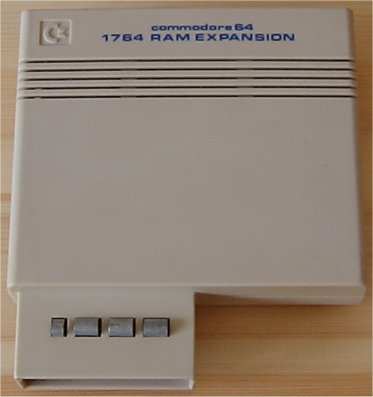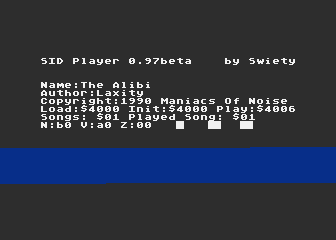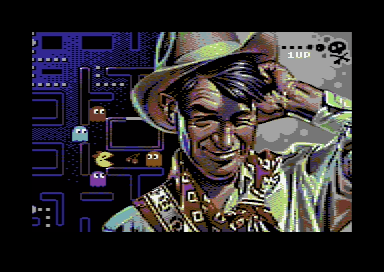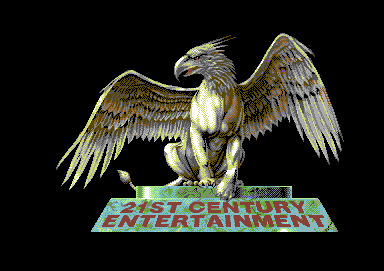AtariXL vs C64
category: general [glöplog]
Vscd,
I may sound repetitive, but saying ".. extending it's base is a shame." is simply not right. You still don't see and accept the fact, that XL/XE memory expansions were standard just like it was for the Amiga500 1MB. I think it was not the case with the C64, am I right (I'm not sure)? Was there ever an official Commodore upgrade for the C64 and official OS/DOS combination which let the user make use of extra ram with (commodore) vendor support?
Expanding the memory was in the 80s the same issue like it is today. The Atari 8bit architecture was designed to be RAM-expandable. The more RAM the more ->comfortable<- you could use the machines capabilities. I'm not talking about upgrading the Antic, 6502 processor or sound chip. On this I fully agree regarding your points. Upgrading the actual base platform like in your example with the color registers is really lame and is of course out of discussion.
I may sound repetitive, but saying ".. extending it's base is a shame." is simply not right. You still don't see and accept the fact, that XL/XE memory expansions were standard just like it was for the Amiga500 1MB. I think it was not the case with the C64, am I right (I'm not sure)? Was there ever an official Commodore upgrade for the C64 and official OS/DOS combination which let the user make use of extra ram with (commodore) vendor support?
Expanding the memory was in the 80s the same issue like it is today. The Atari 8bit architecture was designed to be RAM-expandable. The more RAM the more ->comfortable<- you could use the machines capabilities. I'm not talking about upgrading the Antic, 6502 processor or sound chip. On this I fully agree regarding your points. Upgrading the actual base platform like in your example with the color registers is really lame and is of course out of discussion.
@VSCD "640KB is enought!!!"Bill Gates.
@hitchhikr " The c64 is only superior in the sound department, best 8 bits for that" big bullshit...
" best 8bit for sound is not ATARI not C64 but MSX2 + standard MOONSOUND or older FM-PAC (1987) module... Muhahahahhhaaahhh
@hitchhikr " The c64 is only superior in the sound department, best 8 bits for that" big bullshit...
" best 8bit for sound is not ATARI not C64 but MSX2 + standard MOONSOUND or older FM-PAC (1987) module... Muhahahahhhaaahhh
@Vscd>When You are looking at TBL AMIGA demos... That is ok.
PowerPC,128MB RAM...
Or latest PC demos on corequad PC that is OK...
But 256kb Atari not???
But 256kb ZX not???
Muuuhaahhaaaahhhhh
PowerPC,128MB RAM...
Or latest PC demos on corequad PC that is OK...
But 256kb Atari not???
But 256kb ZX not???
Muuuhaahhaaaahhhhh
All cool atari demos can be for 64kb but can you imagine loadings and loadings and loadings....so demo data load and depack in 256kb/1024kb and then the demo runs from RAMDISK...
read and learn then post comments like "The c64 is only superior in the sound department, best 8 bits for that"....
FAQ about several MSX Hardware (music expansions):
http://www.faq.msxnet.org/
FAQ about several MSX Hardware (music expansions):
http://www.faq.msxnet.org/
twh. Hmm, expanding the Amiga is an even difficultier topic, there were some special hacks with the Chip/Fast/WhateverRam. The question for example was, when starts a hack and what's original. I remember I have to solder a Switch for extra Chipmem. And yes, i I hated Atari ST Demos which needed 1 MB RAM. ;)
But back to 8Bit. The C64 is designed to have an Memoryextension, too. The full Bus is mirrored on the extension-port. There was a fully *offical* Commodore Upgrade for it: the REU, in 128kB, 256kB and 512kB sizes (even more if you did it by your own. Up to 16MB). You could not use the memory directly due the limits of the 6502, but that's the same on the Atari (it was not like the normal bankswitching, it was designed to mirror the Content of the REU into the C64 but the result is equal). For example GEOS used the RAM a lot or GoDot. The speed is amazing, you can read a byte within an cycle. The handling is quite easy,too... even in basic you could do a fullscreen Movie with at least 25 frames/sek. But no one used it. It's like two different cultures... I even dare to believe that if the scene had adopt those hardwareextensions too easily they later would have used the SuperCPU (65816 at 20MHz) or the stereo Sid. Nice features to have but it would be not the same C64scene I've been adored to. If I would ever code something with my IDE-Interface, the SD-Card, the mp3-module or whatever is on my desk I would enter it in a wild-compo.

But back to 8Bit. The C64 is designed to have an Memoryextension, too. The full Bus is mirrored on the extension-port. There was a fully *offical* Commodore Upgrade for it: the REU, in 128kB, 256kB and 512kB sizes (even more if you did it by your own. Up to 16MB). You could not use the memory directly due the limits of the 6502, but that's the same on the Atari (it was not like the normal bankswitching, it was designed to mirror the Content of the REU into the C64 but the result is equal). For example GEOS used the RAM a lot or GoDot. The speed is amazing, you can read a byte within an cycle. The handling is quite easy,too... even in basic you could do a fullscreen Movie with at least 25 frames/sek. But no one used it. It's like two different cultures... I even dare to believe that if the scene had adopt those hardwareextensions too easily they later would have used the SuperCPU (65816 at 20MHz) or the stereo Sid. Nice features to have but it would be not the same C64scene I've been adored to. If I would ever code something with my IDE-Interface, the SD-Card, the mp3-module or whatever is on my desk I would enter it in a wild-compo.

@twh>Yes they [C64 users] have 16 MB of SIMM CMD RamLink expansion...
Standard device...
And SuperCPU 20 MHz Turbo board...
And MMC cartrige...
But I have not seen any cool demo as NUMEN (2xPOKEY,320kb Ram,FDD) for that C64...
I has C128 but...
I have rather buyed 2xAtari130XE...
ATARI RULES!!!
Standard device...
And SuperCPU 20 MHz Turbo board...
And MMC cartrige...
But I have not seen any cool demo as NUMEN (2xPOKEY,320kb Ram,FDD) for that C64...
I has C128 but...
I have rather buyed 2xAtari130XE...
ATARI RULES!!!
And on ATARI We have SID Player... Have You on C64 any Atari Pokey songs player???

Standard 64kb ATARI...
And Pokey can play Amiga MOD too...
tinctu! You know the TBL-Demos I guess. Then you should be awared of the fact that most of the remaining Amiga-Coders are proud to code on 68k CPUS, *only*. Just guess why.
The other sentences below are misqualified to be answered.
The other sentences below are misqualified to be answered.
@vscd: eh, I was just kidding :) I prefer stuff running on a stock machine too, that's part of the challenge in my opinion. I'm not much into the 8bit Atari, just watching some demos on emulator (hmm... maybe I should not have said that :) but from what I've understood, it seems to have the same problem as the CPC (and probably other 8bit) when it come to disc I/O, all the handshaking with the drive have to be done by the CPU with short and precise timings, so it's not just an IRQ slowing down thing, it's (almost) freezing everything while loading data (even playing a music is a really tedious job). That's one of the main reason why almost all of the CPC demos are boring oldskool-onescreener and not fancy multiparts. So I can understand why and I'm glad the Atari freaks use RAM expansion to do something else than onescreeners or jerky multiparts freezing every 30s while loading the next effect, even if I won't do it myself (WTF! Soldering on the mainboard?! Crap! No way! :).
About which 8bit is the best and most famous, well, I don't give a shit since all the latest 8bit demos looks like crap on my original green-monitor :)
About which 8bit is the best and most famous, well, I don't give a shit since all the latest 8bit demos looks like crap on my original green-monitor :)
Quote:
read and learn then post comments like "The c64 is only superior in the sound department, best 8 bits for that"....
FAQ about several MSX Hardware (music expansions):
http://www.faq.msxnet.org/
Moonsound isn't standard, all 8 bits msx were provided with a AY-3-8910, the last msx was produced in 1991, it was the turbo-r and it's not even a 8 bits computer since it contains a 16 bits r800 as second processor.
The moonsound card was made in 1995 you call that standard ? "It was designed by electronic engineer Henrik Gilvad and produced by Sunrise Swiss on a semi-hobby basis."
The c64 is only superior in the sound department, best 8 bits for that.
@vscd:Yep Yep I know TBL production good... 68060 is not bad CPU... Check MIPS table... better than old Pentium...
I go sleep...
I don´t want make next war...
I listen to SIDs...
I check new C64 pixel pictures...
I play C64 games on TV...
I have good C64 friends...
So stop make that stupid war...
8BIT scene is ONE SCENE!!!
I love ATARI,SEGA,GBA and N64,PC...
And AMIGA600 was cutest computer ever made...
So stop please...
I go sleep...
I don´t want make next war...
I listen to SIDs...
I check new C64 pixel pictures...
I play C64 games on TV...
I have good C64 friends...
So stop make that stupid war...
8BIT scene is ONE SCENE!!!
I love ATARI,SEGA,GBA and N64,PC...
And AMIGA600 was cutest computer ever made...
So stop please...
@hitchhikr: FM-PAC was OPL2.
OPL2 is Soundblaster... (Before Pro and 16)
OPL2 sounds much better than SID...
FM-PAC was done in 87 and was real standard!!!
Or SCC by KONAMI...
Yes Moonsound was done in 1995...
It is now standard on MSX2...
Turbo-R was core-duo 8bit Zilog and 16bit RISC Zilog too... (Like on C128)
So has 8bit mode too...
And better soundchip as SID...
Howk...
OPL2 is Soundblaster... (Before Pro and 16)
OPL2 sounds much better than SID...
FM-PAC was done in 87 and was real standard!!!
Or SCC by KONAMI...
Yes Moonsound was done in 1995...
It is now standard on MSX2...
Turbo-R was core-duo 8bit Zilog and 16bit RISC Zilog too... (Like on C128)
So has 8bit mode too...
And better soundchip as SID...
Howk...
Quote:
@hitchhikr: FM-PAC was OPL2.
OPL2 is Soundblaster... (Before Pro and 16)
OPL2 sounds much better than SID...
FM-PAC was done in 87 and was real standard!!!
Or SCC by KONAMI...
OPL2 was also in adlib soundcards,
The MSX-MUSIC external cartridge was not provided on most msx afaik, while the SID was cramed inside the machine from the start (like the msx had the AY-3-8910), it's a little bit more standard that the moonsound but frankly if the SID or even the AY are still around today while others like the OPL2 are more or less gone that's for a reason.
Quote:
Turbo-R was core-duo 8bit Zilog and 16bit RISC Zilog too... (Like on C128)
So has 8bit mode too...
And better soundchip as SID...
You can't consider the turbo-r as a 8 bits computer, both processors could communicate together and the r800 (a z800) could even emulate the z80 to make the old software run faster and was the primary processor of the turbo-r.
The c128 had a z80 and to run cp/m stuff i don't think they could run at the same time or share datas.
As for the gfx side the msx2 probably owned every other 8 bits.
it is somewhat strange that productions considered as best on both platforms have slightli different approach. on c= all you need is plain hadrware, on /|\ you need mods, mods, mods.
looks like atari scene took the "easier" way, infact it's like stabbing yourself in the back, running away from the real challenge.
on the other hand c= has tons of dtv toys with extra features and noone (almost) is using it, such purism is a bit sad.
anyway, i think it is much easier to stretch your muscless when you're on steroids, and i would kill to see a man running 100m below 5 but...
yeah, it happened to amiga on a large scale, and there were two sides always. for some, it will take years to consider BOTH approaches interesting.
looks like atari scene took the "easier" way, infact it's like stabbing yourself in the back, running away from the real challenge.
on the other hand c= has tons of dtv toys with extra features and noone (almost) is using it, such purism is a bit sad.
anyway, i think it is much easier to stretch your muscless when you're on steroids, and i would kill to see a man running 100m below 5 but...
yeah, it happened to amiga on a large scale, and there were two sides always. for some, it will take years to consider BOTH approaches interesting.
I had atari 8 bit / st.. also c64 / spectrum.. amiga.. out of all them machines.. my least favourite was amiga.. ST I could use for c-lab , so that was fine for me =)
so hopefully I'll be objective, but my fav will have to be the c64 followed by the speccy.. sorry.
as for atari 8 bit, if you didn't own a disk drive you were f****d and had to suffer stupidly long loading times... try getting atari games in the shops.. again terrible..
as for demos, yep I liked some of the atari stuff I've seen, but theres plenty of groups on the c64 who i admire far more.. sorry
I guess its partly down to not the machines, but what the people could do with them. the most obvious thing being game conversions..
prime example.. the game green beret.. play it on atari / 64 / spectrum
atari one is woeful, c64 is close to the arcade but my fav one is the spectrum version.
the sheer number of people doing things on c64 was part of it I guess.
I mean, say the game.. zybex.. on both machines good...
elektraglide/rescue on fractalus were better on the atari due to the colour...
so tricky really.
hitchhikr.. have you seen the c128 demo by crest? thats very nice :)
I guess its down to what people do with the machine , rather than it's limitiations.
so hopefully I'll be objective, but my fav will have to be the c64 followed by the speccy.. sorry.
as for atari 8 bit, if you didn't own a disk drive you were f****d and had to suffer stupidly long loading times... try getting atari games in the shops.. again terrible..
as for demos, yep I liked some of the atari stuff I've seen, but theres plenty of groups on the c64 who i admire far more.. sorry
I guess its partly down to not the machines, but what the people could do with them. the most obvious thing being game conversions..
prime example.. the game green beret.. play it on atari / 64 / spectrum
atari one is woeful, c64 is close to the arcade but my fav one is the spectrum version.
the sheer number of people doing things on c64 was part of it I guess.
I mean, say the game.. zybex.. on both machines good...
elektraglide/rescue on fractalus were better on the atari due to the colour...
so tricky really.
hitchhikr.. have you seen the c128 demo by crest? thats very nice :)
I guess its down to what people do with the machine , rather than it's limitiations.
old64scener: I wonder why there are so few C128 demos... or did I just missed them?
"c64 is only superior in sound"
..and maybe in sprites, char / bitmapmodes aswell, overall c64 as a game machine is better, and was much cheaper. thats why the c64 became the ford t-model of home computers in the 80s.


"And on ATARI We have SID Player... Have You on C64 any Atari Pokey songs player???"
no. why would we need one? :) you're fighting for the sound we have. we dont have to fight for it. we have it.
..and maybe in sprites, char / bitmapmodes aswell, overall c64 as a game machine is better, and was much cheaper. thats why the c64 became the ford t-model of home computers in the 80s.


"And on ATARI We have SID Player... Have You on C64 any Atari Pokey songs player???"
no. why would we need one? :) you're fighting for the sound we have. we dont have to fight for it. we have it.
comankh,
statements like "on /|\ you need mods, mods, mods.
looks like atari scene took the "easier" way, infact it's like stabbing yourself in the back, running away from the real challenge." show me how less you know about the 8bit Atari.
The first 8bit Atari's had 16kb (400) and 48kb (800). The configuration of these machines used in the 1979 is (except for the memory, and some pal/ntsc issues) identically with that, what you would require to run demos like Numen today. We don not require "mods, mods mods". It as simple as ugprading the memory from 16kb to 48kb. Atari user were doing this in the 80s and they are doing this today.We are not seeking for the "easy way" we are just using the Atari as it was supposed by their fathers like Jay Miner.

grtx,
\twh
statements like "on /|\ you need mods, mods, mods.
looks like atari scene took the "easier" way, infact it's like stabbing yourself in the back, running away from the real challenge." show me how less you know about the 8bit Atari.
The first 8bit Atari's had 16kb (400) and 48kb (800). The configuration of these machines used in the 1979 is (except for the memory, and some pal/ntsc issues) identically with that, what you would require to run demos like Numen today. We don not require "mods, mods mods". It as simple as ugprading the memory from 16kb to 48kb. Atari user were doing this in the 80s and they are doing this today.We are not seeking for the "easy way" we are just using the Atari as it was supposed by their fathers like Jay Miner.

grtx,
\twh
a side note for this hilarious thread:
i suppose if you've got your head (and thus, your ears) up your arse and you happen to like things that are (and thus, sound) plastic, sure.
Quote:
OPL2 sounds much better than SID...
i suppose if you've got your head (and thus, your ears) up your arse and you happen to like things that are (and thus, sound) plastic, sure.
Atari XL was my first computer. Then I upgraded to Commodore 64 and I'm still using it ;)
To be honest, before reading this topic I didn't even know Atari XL was faster than C64 (I was 6 years old when I had Atari XL). All I know is somehow Commodore 64 cought most of us from our balls. But XL couldn't.
It's weird because Atari's Basic has nice graphic commands which c64 doesn't have. When I've seen Simon's Basic for the first time, I thought Atari already had most of those graphic commands built-in. So, I always knew Atari XL had some advantages over C64. But I never looked back when I (my parents) bought my first Commodore 64 at 7 years old. Maybe I should have...
Another thing I remember about Atari XL is you can switch between uppercase/lowercase characters without changing all characters in the screen and there is a special key for that (if I remember correctly). Shift+Commodore affects all characters in the screen and if you want uppercase/lowercase letters in the same screen you have to use lowercase mode and use shift key for uppercase letters. That's not a big deal but I had found it strange when I used C64 for the first time. And I still remember the difference :)
Hmm, I think I'll recheck Atari XL. Maybe I can code something on my first computer in 2008 (22 years later).
To be honest, before reading this topic I didn't even know Atari XL was faster than C64 (I was 6 years old when I had Atari XL). All I know is somehow Commodore 64 cought most of us from our balls. But XL couldn't.
It's weird because Atari's Basic has nice graphic commands which c64 doesn't have. When I've seen Simon's Basic for the first time, I thought Atari already had most of those graphic commands built-in. So, I always knew Atari XL had some advantages over C64. But I never looked back when I (my parents) bought my first Commodore 64 at 7 years old. Maybe I should have...
Another thing I remember about Atari XL is you can switch between uppercase/lowercase characters without changing all characters in the screen and there is a special key for that (if I remember correctly). Shift+Commodore affects all characters in the screen and if you want uppercase/lowercase letters in the same screen you have to use lowercase mode and use shift key for uppercase letters. That's not a big deal but I had found it strange when I used C64 for the first time. And I still remember the difference :)
Hmm, I think I'll recheck Atari XL. Maybe I can code something on my first computer in 2008 (22 years later).
Quote:
..and maybe in sprites, char / bitmapmodes aswell,
No. As far as i know the graphic chip of the msx 2 have no equivalent in the non extended 8 bits world, here are the facts:
- 512 colours palette with a 9-bits resolution (777 like the Atari ST).
- 10 Graphics modes:
- 40 characters per line of text, one colour (width=40) | for each character
- 80 characters per line of text (width=80) | character blinkable selection
- pseudo-graphic, one character divided into four block
- 32 characters per one line of text, colored character available
- 256 x 192, the colour is specififed for each 8 dots
- 256 x 192, the colour is specififed for each 8 dots + sprite in mode 2
- 256 x 212; 16 colours are available for each dot
- 512 x 212; 4 colours are available for each dot
- 512 x 212; 16 colours are available for each dot
- 256 x 212; 256 colours are available for each dot (chunky mode)
- 32 Sprites (up to 8 on 1 line).
- Interlace possible (max 512 x 424).
- 128k of max. 30ns dedicated video memory (not shared with the main ram).
- Line drawing / block copying / Pattern searching hw blitter.
All these machines have more or less great technical specifications but ultimately it all depends on what we do with them.
ltk_tscc :demo is, Risen From Oblivion VDC by Crest & Oxyron
so few, because I guess well you have to code differently.. also some VDC chips in the machines are different.. also not as many c128's about now. the c64 outsold it by a lot.
although people are doing nice dtv demos.
so few, because I guess well you have to code differently.. also some VDC chips in the machines are different.. also not as many c128's about now. the c64 outsold it by a lot.
although people are doing nice dtv demos.
this thread roxx!!!
